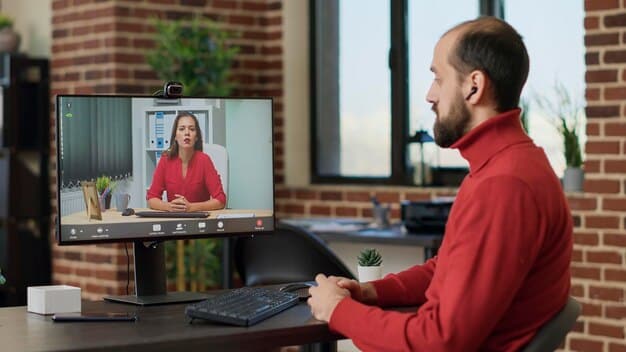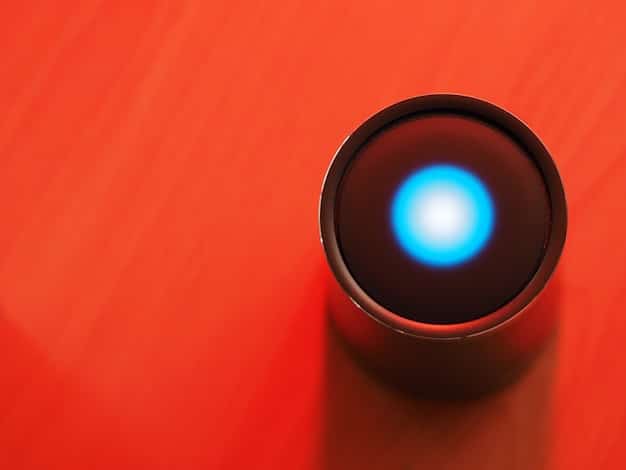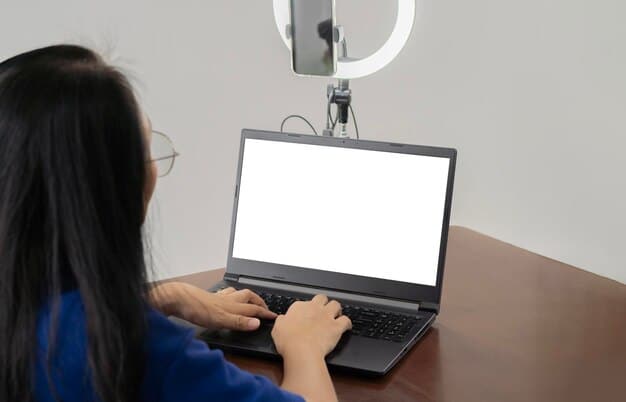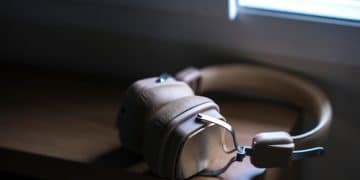The Best $75 Webcam for Remote Work: Image Quality, Audio, Features

Finding an optimal webcam for remote work under $75 requires a careful balance of image quality, audio clarity, and essential features to ensure professional and reliable virtual communication, enhancing your productivity without breaking the bank.
In today’s remote-first world, a high-quality webcam is no longer a luxury but a fundamental tool. For those seeking to enhance their virtual presence without overspending, finding the best $75 webcam for remote work: image quality, audio, and features that truly matter, becomes a strategic investment.
The Fundamentals: What Defines a Great Webcam for Remote Work?
When you’re working remotely, your webcam is your window to the professional world. It’s not just about seeing and being seen; it’s about clear communication, impactful presentations, and maintaining a strong connection with colleagues and clients. The threshold of $75 can seem limiting, but with careful review, stellar options emerge.
Beyond basic functionality, a great webcam for remote work offers reliability and performance that minimizes distractions and maximizes engagement. It should integrate seamlessly with your existing setup, whether you’re using a desktop or a laptop, a Windows PC or a Mac.
Image Quality: Beyond Just Pixels
While 1080p is often touted as the standard, true image quality goes far beyond mere resolution. Factors like frame rate, low-light performance, and auto-focus capabilities play a crucial role in how professional and clear your video stream appears, even in challenging lighting conditions.
A webcam with good image quality can dramatically improve how you are perceived in virtual meetings. It ensures that your facial expressions are clear, and your environment (if visible) is presented in a favorable light without excessive graininess or distortion.
- Resolution and Frame Rate: Aim for 1080p at 30fps for smooth, clear video. Some budget options might offer 60fps at lower resolutions, which can be beneficial for fast movements.
- Low-Light Correction: Essential for varying lighting environments, ensuring you remain visible even if your workspace isn’t perfectly lit.
- Autofocus and Field of View: A responsive autofocus keeps you sharp, while a balanced field of view prevents your background from becoming too distracting or too restrictive.
Exploring various sensor sizes and lens types can also reveal subtleties in image capture that elevate a webcam above its peers. Larger sensors and glass lenses typically yield better light capture and sharper images, even on a budget.
Audio Performance: Your Voice Matters
Often overlooked, audio quality is just as important as video. A webcam with a poor microphone can make even the most insightful comments difficult to understand, leading to frustration and miscommunication. Integrated microphones must be capable of capturing clear audio while minimizing background noise, especially in a home office environment.
Many webcams feature dual microphones or noise-canceling technology, which are invaluable for remote work. These features help to isolate your voice from ambient sounds like keyboard clicks, air conditioning, or children playing in the background, ensuring you come across loud and clear.
- Noise-Canceling Microphones: Crucial for filtering out ambient noise and focusing on your voice.
- Omnidirectional vs. Unidirectional: Omnidirectional mics pick up sound from all directions, which can be useful, but unidirectional or noise-canceling options are often better for isolating a single voice.
- Voice Clarity: The microphone should capture a natural range of your voice without sounding tinny or muffled.
Even if you plan to use a dedicated headset, the webcam’s built-in microphone serves as an excellent backup, and its quality contributes significantly to the overall value proposition of the device.
Ultimately, a great webcam for remote work within the $75 budget successfully balances visual clarity with audio precision, providing a cohesive and professional communication experience. It should allow you to participate in meetings confidently, knowing that your image and voice are being transmitted effectively.
Key Features to Prioritize in a $75 Webcam
Navigating the webcam market under $75 means making informed choices about which features truly enhance your remote work experience. It’s not about having every bell and whistle, but rather focusing on the functionalities that deliver the most bang for your buck and directly impact your daily virtual interactions.
Beyond the core image and audio quality, several other features can significantly contribute to the overall utility and user-friendliness of a budget-friendly webcam. Understanding these can help you sift through the myriad of options available.

Privacy and Security Features
In an age where privacy concerns are paramount, a physical privacy shutter is a non-negotiable feature for many remote workers. This simple addition provides peace of mind, ensuring that your camera isn’t inadvertently on when you don’t want it to be. Software-based solutions are often less reliable.
Moreover, features that allow for easy disabling of the microphone without fumbling through software settings can also add an extra layer of security and convenience, preventing accidental audio broadcasts. Look for models that integrate these elements seamlessly.
Security goes beyond just physical covers; it also pertains to the webcam’s software and how it handles data. Reputable brands are more likely to adhere to privacy standards and offer reliable, secure drivers and firmware updates.
Mounting Options and Versatility
A good webcam should be flexible in how it adapts to your workspace. Whether you prefer to clip it onto your monitor, place it on a tripod, or set it on your desk, versatile mounting options are crucial. A robust and stable clip prevents wobbling, ensuring a steady image throughout your calls.
Some webcams come with tripod threads, allowing for more precise positioning and stability, which can be particularly useful if you have a non-standard monitor or prefer to position your camera away from your screen. The ability to pivot and tilt the camera is also valuable for adjusting your framing.
Software and Compatibility
While most webcams are “plug and play” with popular operating systems like Windows and macOS, some offer dedicated software that unlocks additional features. This might include fine-tuning image settings (brightness, contrast, white balance), digital zoom, or even custom filters. However, often the basic drivers are sufficient.
Ensure the webcam is compatible with your preferred video conferencing platforms (Zoom, Microsoft Teams, Google Meet, Skype, etc.) and operating system. While most modern webcams are universally compatible, reviewing user feedback on specific software interactions can prevent future headaches.
- Plug and Play: Most webcams offer immediate functionality without complex installations.
- Proprietary Software: Some brands provide software for advanced controls like color correction or field of view adjustments.
- OS Compatibility: Verify support for Windows, macOS, and potentially Linux or Chrome OS.
The best $75 webcam for remote work isn’t necessarily the one with the most features, but the one that most effectively combines essential capabilities with user-friendly design, ensuring a seamless and productive virtual interaction experience.
Top Contenders: Webcams Under $75 That Deliver
Identifying the top contenders in the under-$75 webcam category requires a critical look at popular models that consistently receive positive feedback for their performance in remote work scenarios. While marketing can be compelling, real-world user experiences and expert reviews provide the most reliable insights.
It’s important to recognize that no single webcam will be perfect for everyone. Factors like your specific lighting conditions, the size of your workspace, and your audio preferences will influence which model is the best fit. However, certain webcams stand out repeatedly for their solid performance and value.
Logitech C920 series (Refurbished/Sale)
The Logitech C920, and its variations like the C920s or C922, often appear on lists of best webcams, and for good reason. While new units typically exceed $75, refurbished models or those found on sale often fall within this budget. They offer consistently excellent 1080p video quality at 30fps and reliable autofocus.
The C920 series is renowned for its dual omnidirectional microphones with noise reduction, providing clear audio that often surpasses cheaper alternatives. Its robust mounting clip is versatile, fitting securely on most monitors and laptops, and it frequently includes a privacy shutter (especially the C920s variant), addressing a key remote work concern.
The longevity and widespread compatibility of the C920 series speak to its robust design and driver support. Many users find its software (Logitech G HUB or older Camera Settings) provides sufficient control without being overly complex.
Razer Kiyo (Sale/Older Model)
While primarily marketed to streamers, the Razer Kiyo’s unique integrated ring light makes it an intriguing option for remote workers struggling with poor lighting. The original Kiyo can sometimes be found within the $75 budget, especially during sales or as an older model.
Its 1080p 30fps video with autofocus is solid, but the standout feature is undoubtedly the adjustable ring light. This can dramatically improve your lighting conditions, making you appear brighter and more professional without needing external lighting equipment. The built-in microphone is decent but might not be its strongest point.
The Kiyo’s design is fairly compact, and its mount is sturdy. For those working in variable or dimly lit environments, the convenience of the integrated light can justify its slightly higher price point or the effort to find it on discount.
Anker PowerConf C200
Anker, known for its reliable accessories, has entered the webcam market with strong contenders. The PowerConf C200 generally hovers just above the $75 mark, but sales can make it a viable option. It boasts 2K resolution (2560×1440) at 30fps, offering a sharper image than many 1080p counterparts.
This webcam features dual stereo microphones with AI noise reduction, designed to significantly improve audio clarity in bustling environments. It also includes an adjustable field of view, allowing you to choose between 65, 78, or 95 degrees, which is excellent for framing yourself appropriately.
The included privacy cover and software for advanced settings make the C200 a compelling package for remote workers seeking a premium experience at a budget-friendly price point. Its image quality, especially in good lighting, is often praised for its vibrancy and detail.
These models represent the cream of the crop within the $75 price range, each offering a unique set of advantages from superior audio to integrated lighting or higher resolution, catering to different remote work needs and preferences.
Setting Up Your $75 Webcam for Optimal Performance
Acquiring the best $75 webcam for remote work is only half the battle; setting it up correctly for optimal performance significantly impacts your professional appearance and communication effectiveness. Even the most advanced webcam can underperform if not properly configured and positioned.
Many users simply plug in their webcams and start using them, missing out on crucial adjustments that can elevate their video conferencing experience from adequate to excellent. A few simple steps can make a noticeable difference.
Positioning and Framing
The angle and height of your webcam are paramount. Ideally, your webcam should be at eye level, or slightly above, to create a natural and engaging perspective. Avoid placing it too low, as this can result in an unflattering “up-the-nose” shot.
Ensure your face is well-centered in the frame, with enough headroom but not too much empty space above your head. Consider the rule of thirds for a more aesthetically pleasing composition. Your background should be tidy and professional, or at least neutral, to minimize distractions.
- Eye Level: Position the camera to look straight at you.
- Good Framing: Center your face, leaving some headroom.
- Clean Background: Minimize clutter and distractions behind you.
If your webcam doesn’t reach eye level, consider using a small stack of books or a webcam stand to elevate it. Experiment with different positions until you find what looks most natural and professional.
Lighting Your Scene
Good lighting is often more important than the webcam itself. Natural light from a window in front of you is ideal, providing soft, even illumination. Avoid having bright light sources directly behind you, as this will silhouette you and make you appear dark.
If natural light isn’t available, consider using a small desk lamp or an LED ring light positioned in front of you. Soft, diffused light is preferable to harsh, direct light, which can create strong shadows. Even a simple white sheet or piece of paper can act as a diffuser for a lamp.
Many webcams, especially in the $75 range, struggle in low-light conditions, producing grainy or muddy images. Investing a small amount in a basic lighting setup can dramatically improve your video quality, making you look more vibrant and professional during calls.
Software Adjustments and Maintenance
Even budget webcams often come with basic software or settings accessible through your operating system or video conferencing platform. Take the time to explore these settings. Adjustments like white balance, exposure, and contrast can significantly improve your image quality.
Ensure your webcam’s drivers are up to date. Manufacturers occasionally release updates that improve performance, stability, or add new features. Regularly cleaning your webcam’s lens with a soft, lint-free cloth can also prevent blurry or smudged images.
By investing a little time in proper setup and maintenance, you can ensure that your $75 webcam delivers maximum performance, allowing you to present your best self in every virtual interaction.
Common Challenges and Solutions with Budget Webcams
While a $75 webcam can offer impressive value, it’s realistic to expect some limitations. Understanding common challenges associated with budget models and knowing how to troubleshoot them can save you significant frustration and ensure a smoother remote work experience.
The key is to set realistic expectations and proactively address potential issues. Many common problems have simple, practical solutions that don’t require advanced technical knowledge or further investment.
Poor Low-Light Performance
One of the most persistent challenges with webcams under $75 is their tendency to struggle in dim lighting. Images can become grainy, colors can appear washed out, and the frame rate might drop, resulting in a choppy video feed.
Solution: The most effective remedy is to improve your lighting. Position yourself facing a window or use an external light source, such as a ring light or even a well-placed desk lamp. Ensure the light source is in front of you, not behind, to avoid silhouetting. Experiment with warm vs. cool light temperatures to find what looks most natural.
Adjusting the webcam’s exposure settings within its software or your video conferencing app can also help. Many apps offer a “low light compensation” feature, but external lighting is always superior.
Subpar Audio Quality and Background Noise
Integrated microphones on budget webcams can sometimes pick up too much background noise, making your voice difficult to hear. They might also sound tinny or distant, lacking clarity and depth.
Solution: While some webcams offer noise-canceling, a dedicated headset or external USB microphone is often the best long-term solution for pristine audio, especially if you’re in a noisy environment. However, if that’s not an option, try to reduce ambient noise in your room.
- Reduce Room Echo: Add soft furnishings, curtains, or even blankets to absorb sound.
- Minimize Background Noise: Close windows, turn off loud fans, and inform household members about your call schedule.
- Software Noise Suppression: Utilize noise suppression features within your video conferencing software (e.g., Zoom’s advanced audio settings).
Speaking clearly and directly into the webcam’s microphone (if you’re not using a headset) also helps. Test your audio before important calls to ensure clarity.

Limited Field of View or Fixed Focus
Some budget webcams come with a wide, fixed field of view that captures too much of your background or lack autofocus, leaving you blurry if you move too much.
Solution: For a wide field of view, ensure your background is as professional and uncluttered as possible. You can also use virtual backgrounds within your video conferencing software, though these require sufficient lighting and a relatively uniform background to work well.
For fixed-focus webcams, position yourself at the optimal distance from the camera where you appear sharpest. Avoid leaning too far forward or backward. If available, use any digital zoom features in your webcam’s software to crop out unnecessary background, but be aware that digital zoom often reduces image quality.
Understanding these common pitfalls and applying these solutions can help you maximize the potential of your $75 webcam, ensuring a more professional and less frustrating remote work experience.
Future-Proofing Your Remote Work Setup on a Budget
While “future-proofing” a tech gadget, especially a budget one, might seem contradictory, it’s about making smart choices that extend the useful life of your $75 webcam and anticipate evolving remote work needs. It’s about value over time, not just initial cost.
Considering how rapidly technology changes, focusing on core functionalities and open standards can ensure your webcam remains relevant for longer. It’s about selecting a device that can adapt to new software and new demands without needing immediate replacement.
Prioritize Software Compatibility and Updates
A webcam’s hardware specifications are important, but its longevity often hinges on software support. Choose models from established manufacturers known for providing regular driver updates and ensuring compatibility with the latest operating systems and video conferencing platforms.
Frequent updates indicate a commitment from the manufacturer to improve their product and address any vulnerabilities or compatibility issues. This ongoing support extends the webcam’s useful life and ensures it performs reliably with future software iterations.
Invest in Accessories Wisely
Sometimes, the “future-proofing” isn’t in the webcam itself, but in the complementary accessories. A universal tripod mount, for instance, can enhance stability and positioning flexibility across multiple webcam generations.
Consider a small, dimmable LED ring light. This is an accessory that will significantly improve the video quality of any webcam, high-end or budget, and can be reused if you eventually upgrade your camera. A quality USB extension cable can also offer more versatility in placement.
- Universal Mount: Ensures adaptability to various setups.
- External Lighting: Improves image quality regardless of webcam model.
- Quality USB Cable: Provides flexible placement options.
These accessories are often one-time purchases that enhance your entire remote work setup, not just the webcam. They represent smart investments that contribute to a consistently professional virtual presence.
Consider Resale Value and Durability
While a $75 webcam isn’t a major investment, choosing a model from a reputable brand with a reputation for durability, like Logitech, can offer some resale value down the line. Built-to-last construction means fewer replacements and less electronic waste.
Models made with sturdy materials and thoughtful design tend to withstand daily use better. Reading user reviews about long-term reliability can offer insights into how well a webcam holds up over time, which is a key aspect of future-proofing on a budget.
Ultimately, future-proofing your budget remote work setup involves making informed choices about webcam features, prioritizing software support, strategically investing in complementary accessories, and opting for durable products, ensuring long-term value and sustained professional performance.
| Key Point | Brief Description |
|---|---|
| 📸 Image Quality | Focus on 1080p 30fps with good low-light correction and autofocus. |
| 🎤 Audio Performance | Seek noise-canceling or dual microphones for clear voice capture. |
| 🔒 Privacy Features | A physical privacy shutter is a highly recommended feature. |
| 🔄 Versatility | Look for flexible mounting options and broad software compatibility. |
Frequently Asked Questions
▼
Absolutely. Many webcams in the $75 range offer 1080p resolution and decent audio, which is more than adequate for professional video calls and online meetings. Focusing on key features like good lighting and proper setup can make a budget webcam perform exceptionally well for remote work.
▼
Image quality and audio clarity are paramount. A 1080p resolution with a smooth frame rate (30fps) ensures clear visuals, while noise-canceling microphones are crucial for clear communication by minimizing distracting background sounds, making your virtual presence professional and effective.
▼
Yes. While an external microphone or headset is the best solution, you can also improve built-in audio by reducing room echo with soft furnishings, minimizing ambient noise, and utilizing noise suppression features within your video conferencing software, enhancing overall audio quality.
▼
A physical privacy shutter is highly recommended for peace of mind. It provides absolute certainty that your camera lens is blocked when not in use, preventing accidental broadcasts and enhancing your digital privacy more reliably than software-only solutions, a significant benefit for remote workers.
▼
Lighting significantly impacts your webcam’s image quality. Proper lighting, ideally from in front of you, ensures a clear, well-exposed image, reducing graininess and making you appear more professional. Poor or backlighting can lead to dark, distorted video, regardless of webcam quality.
Conclusion
Navigating the landscape of webcams under $75 reveals that high-quality remote work communication is entirely achievable without a hefty investment. By prioritizing crucial elements such as clear image quality (1080p, good low-light performance, and reliable autofocus), crisp audio through noise-canceling microphones, and practical features like privacy shutters and versatile mounting, you can significantly elevate your virtual presence. The best $75 webcam for remote work isn’t about compromise, but about making informed choices that deliver the most impact on your professional interactions. With careful selection and optimal setup, these budget-friendly devices can be powerful tools that keep you connected, clear, and professional in every virtual meeting.





